|
|
|
Sort Order |
|
|
|
Items / Page
|
|
|
|
|
|
|
| Srl | Item |
| 1 |
ID:
126305
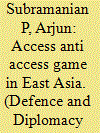

|
|
|
|
|
| Summary/Abstract |
The East Asian theatre is emerging as a region where there are frequent military confrontations. The territorial disputes are the pivot of all recent tensions in the region. China, backed by its increasing economic and military might, is turning more assertive in its claims. The dispute might be regional but any military flare up has few changes of being limited to the regional players. This is because of the security architecture in the region, in which the United States in an important external actor. This is a cause of major concern for China, particularly in the event of a possible non-pacific reunification of Taiwan with the Chinese Mainland or a war with Japan over the island dispute. At present, the US is the only power that could challenge the Chinese military supremacy in the region. Back in the 1996 Taiwan Crisis, the US had deployed two of its aircraft carriers as a signal to China of its resolve to maintain the status quo in the region. Ever since, China began to develop an Anti-Access and Area Denial (A2/ AD) strategy with the sole aim of preventing the US military from intervening in any conflict in the region involving China. This paper looks at the Chinese and US military Strategies that are involving in the region. Specific focus in given to the people`s Liberation Army Air Force bomber Aircraft force which has been modified to fire long range Air Launched Cruise Missile (ALCMs) to threaten the US military bases around China, and the future measures that the PLA might take to deny access to US forces in the region.
|
|
|
|
|
|
|
|
|
|
|
|
|
|
|
|
| 2 |
ID:
126306
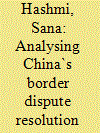

|
|
|
|
|
| Publication |
2013.
|
| Summary/Abstract |
South Asia, as a region, has always ranked high in importance in China`s foreign policy calculations. Since its inception on October 1, 1949, China has had enduring interests in South Asia which is basically a derivative of the subcontinent's location on China`s southwestern flank, next to the troublesome Tibetan and Xinjiang regions. One of the primitive determinants of China`s South Asia policy was its borders dispute with five countries of the region. China shares land border with five South Asian countries, namely, Afghanistan, Bhutan, India, Nepal and Pakistan. These five South Asian countries got involve in latent boundary disputes with China as soon as the People`s Republic of China (PRC) was established and the colonialist power left the Indian subcontinent.
|
|
|
|
|
|
|
|
|
|
|
|
|
|
|
|
| 3 |
ID:
126318
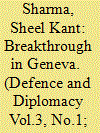

|
|
|
|
|
| Publication |
2013.
|
| Summary/Abstract |
It is just 10 days since Iran its interlocutors reached an interim deal in Geneva and its implementation has commenced with the announcement of a visit by the international Atomic Energy Agency (IAEA) to the heavy water reactor project at Arak. The interim deal is about a temporary freeze, as a first step, in the progress of diverse aspect of the Iranian nuclear program but is of considerable significance even as a first step. This is because of the agreed links in the initial steps, with marginal softening of sanctions and the promise of no more of them. The deal also lays down in a comprehensive package the goal of negotiations and a process towards that goal which has been on the card of many months. An linking of the progress was felt when Iran and the IAEA accepted a work plan on November 11, 2013, to resolve outstanding issues. The subsequent negotiations in Geneva among the foreign Ministers of Iran and the P-5 plus Germany till the wee hours of November 24, 2013, were hard and intensive. Foreign Minister Zarif tweeted on the conclusion these negotiations that "there is white smoke".
|
|
|
|
|
|
|
|
|
|
|
|
|
|
|
|
| 4 |
ID:
126261
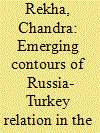

|
|
|
|
|
| Publication |
2013.
|
| Summary/Abstract |
Competition to gain allies and regain one`s status quo in the new international milieu became the norm for many countries in the post bipolar world. The Middle East was no exception for geopolitical competition among influential actors as oil, trade routes and geographical location paved the way for countries trying to regain or preserve their hegemony in the region. Hence, the end of the Cold War phase and the coming of a new world order led many regional players to pursue their national interests in the region which includes Russia and Turkey.
In the playoff among countries in the Middle East, a prerequisite is effectively understanding the factors that motivate Russia`s and Turkey`s foreign policy behavior in the Middle East which is an influential player in the region due to its geographical location and historical linkages. It has become a contested zone for Russia and Turkey even as the US, China and Europe have begun significant roles in the region.
|
|
|
|
|
|
|
|
|
|
|
|
|
|
|
|
| 5 |
ID:
126281
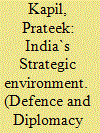

|
|
|
|
|
| Publication |
2013.
|
| Summary/Abstract |
In a nutshell, grand strategy is fundamentally a choice; it reflects a preference for a future state or condition in the strategic environment. Therefore, strategy at the state level can be defined as the art an d science of developing and using the political, economic, socio-psychological and military power of the state to create strategic effect that protect or advance national interests in the environment in accordance with policy guidance. Strategy seeks synergy and symmetry of objectives, concepts, and resources to increase the probabilities and favourable consequence of policy success and to lessen the chances of policy failure.
|
|
|
|
|
|
|
|
|
|
|
|
|
|
|
|
| 6 |
ID:
126263
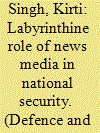

|
|
|
|
|
| Publication |
2013.
|
| Summary/Abstract |
News journalism achieved a new height with the publication of serious revelation made by American computer professional and ex-Central Intelligence Agency (CIA) and National Security Agency (NSA) employee , Edward Joseph Snowden on June 2013. Refreshing the memories of editor-in-chief and founder of Wikileaks, Julian Paul Assange, the recent example has once again exhibited how powerful and deadly the media can be in term of national security. The recent issue has once ignited the same debate on the role of the media: the media as a watchdog of a nation or a medium which provides a voice to the unheard, helps the whistleblowers to expose the cracks in our existing society and by doing so, performs a greater good for the public.
|
|
|
|
|
|
|
|
|
|
|
|
|
|
|
|
| 7 |
ID:
126296
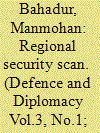

|
|
|
|
|
| Publication |
2013.
|
| Summary/Abstract |
South and Southeast Asia are the `happening place in world politics. India finds itself in a turbulent region that is a challenge to its government as it endeavors to improve the well-being of its masses. The term `regional has to be seen in the context of the aspirations of a proud India and its people who have a rich heritage and whose influence in yesterday extended a great distance beyond its shores. Thus, as India looks beyond its borders for influence and raw materials to ensure its growth and development, its runs up against the other powers of the region who are also in the fray for similar reasons, most notable amongst them being China. But it is necessary to give a sense of dimension to the term `regional' in the first place.
|
|
|
|
|
|
|
|
|
|
|
|
|
|
|
|
| 8 |
ID:
126287
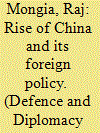

|
|
|
|
|
| Publication |
2013.
|
| Summary/Abstract |
The vast majority of Indians is worried about China`s rise and considers it a security threat, an opinion poll has revealed, with the result exposing a serious trust deficit between the Asian giants. The surveys, conducted by the Lowy Institute for international policy and the Australia Indian Institute, Found that 83 per cent of Indians considered China a security Threat. A possible war with China was rated a "big Threat" by almost three in four respondents. Reasons included China`s possession of nuclear weapon, competition for resources, and border disputes. Even through China is now India`s largest trading partner, just 31 per cent of Indians agreed that China`s rise had been good for India.
|
|
|
|
|
|
|
|
|
|
|
|
|
|
|
|
| 9 |
ID:
126260
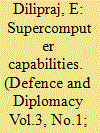

|
|
|
|
|
| Publication |
2013.
|
| Summary/Abstract |
Supercomputers, the monsters of the computing World, occupy enormous rooms and perform trillions of calculations per second. In general, a supercomputer can be defined as a machine with high computing performance that has extremely fast processing speeds which are employed for specialized applications that require immense amounts of mathematical calculation and logical analysis. A supercomputer that process data simultaneously.
The high capacity of such super machine is used for various types of scientific research like recreating the Big Bang, Understanding earthquakes, protein folding, bloodstream mapping, modeling of new diseases, Oceanographic modeling, predicting climate change, weather forecasting, recreating brain patterns, finding the God particle and other atomic and sub-atomic research. While supercomputers are constantly relied upon for performing the above mentioned high end complex civilian scientific research, they are also used almost at the same magnitude by different countries around the globe for defence related research. Therefore, this paper intends to study the role played by these computing giants in the field of defence and the capabilities of various countries possessing such technology.
|
|
|
|
|
|
|
|
|
|
|
|
|
|
|
|
| 10 |
ID:
126286
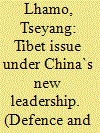

|
|
|
|
|
| Publication |
2013.
|
| Summary/Abstract |
The only substantial mechanism paving the way towards an amicable solution to the ongoing Tibet issue has been the direct dialogue held between the representative of the Dalai Lama and the representative of the people`s Republic of China (PRC). The Dialogue initially commenced in the year 1979, and the recently held round of talk in 2010 resulted in no agreement or common ground between the two sides. The dialogue was carried forward amid serious doubts and skepticism over China`s true intention towards seeking a feasible solution to the Tibet issue. Recently, two Tibetan envoys who participated in the negotiation with China resigned due to the failure of the germinate any concrete solution, expressing their frustration over the lack of positive response from Beijing amid ongoing exacerbation of the situation in Tibet, simultaneously expressing their helplessness as Beijing was not reciprocation any of the concessions and sacrifices made by their side. However, keeping the hopes alive, the Tibetan government-in-exile, known as the Central Tibetan Administration, signaled that it is ready to engage in a meaningful dialogue, anywhere and at any time.
|
|
|
|
|
|
|
|
|
|
|
|
|
|
|
|
|
|
|
|
|